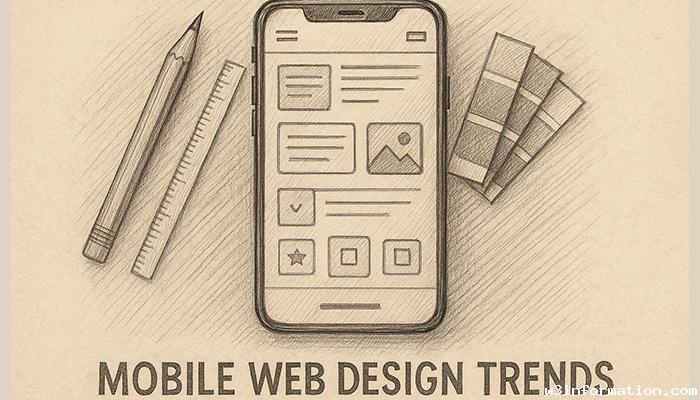Mobile Web Design Trends
The growing dominance of mobile internet usage over desktop makes smartphone and tablet user experience design essential for websites today. Mobile web design continues to progress in order to deliver high speed, user-friendly interfaces and attractive visuals for compact displays. Adhering to current mobile web design trends keeps your site modern and attractive while maintaining easy access for users. This blog post examines the leading mobile web design trends in 2025 that guide businesses and developers in building powerful and smooth mobile experiences.
Minimalistic and Clean Design
Limited screen space requires designers to focus on minimalistic design principles. Mobile device content becomes more readable and user-friendly when clean layouts with significant white space minimize visual clutter.
- Focus on essential elements.
- Use simple navigation menus.
- Prioritize content hierarchy and readability.

Dark Mode Compatibility
Dark mode functionality has gained widespread adoption across apps and operating systems while mobile websites begin to incorporate this feature too.
- Offers reduced eye strain in low-light environments.
- OLED and AMOLED screens experience extended battery life through dark mode usage.
- Adds a modern, sleek aesthetic to sites.
Dark mode toggle options deliver improved comfort and user engagement.
Micro-Interactions and Animations
Micro-interactions and subtle animations boost user engagement while providing feedback during actions like button clicks or form submissions.
- Use animations to guide users.
- Keep interactions lightweight to maintain performance.
- Enhance user experience without overwhelming the interface.
Voice User Interface (VUI)
Mobile users demonstrate growing use of voice search and commands to enable hands-free interactions.
- Optimize mobile sites for voice search SEO.
- Design interfaces that support voice navigation.
- Incorporate voice-activated features where relevant.
Progressive Web Apps (PWAs)
PWAs deliver the combined advantages of websites and native apps by providing quick, dependable and captivating mobile experiences.
- Offline functionality.
- Push notifications.
- App-like performance without installation.
Progressive Web Apps (PWAs) have become more popular because they represent a mobile-first solution.
Responsive and Adaptive Design
Adaptive design grows in popularity while responsiveness stays standard because it allows experiences to be customized for particular devices and contexts.
- Responsive design adjusts layout fluidly.
- Adaptive design offers distinct layouts and features that match each device type.
- Integrating responsive and adaptive design methods delivers the best possible experience for users across all mobile platforms.
Bold Typography and Large Buttons
Mobile devices users gain advantages from fonts that are easy to read and buttons which require minimal effort to tap.
- Apply large and readable font styles in both headings and body text.
- Ensure buttons and clickable areas satisfy minimum touch target size requirements.
- Improve accessibility and reduce user frustration.
Fast Loading Times
Mobile network performance remains essential because user speeds differ widely.
- Optimize images and assets.
- Minimize code and third-party scripts.
- Leverage caching and content delivery networks (CDNs).
Mobile sites that load quickly decrease bounce rates while simultaneously enhancing search engine optimization.
Augmented Reality (AR) Integration
Mobile sites now frequently integrate AR components to improve interactive capabilities.
- Virtual try-ons for e-commerce.
- Interactive product demonstrations.
- Engaging marketing campaigns.
AR creates immersive experiences which lead to increased user engagement and higher conversion rates.
Conclusion
The evolution of mobile web design proceeds swiftly due to the combined effects of user behavior transformations and technological progress. Mobile sites will maintain their competitive edge in 2025 through minimalism and accessibility combined with performance while adopting voice interfaces and AR technology. Businesses that thoughtfully integrate these trends will create mobile experiences that engage users through seamless design and usability which generates results and fosters enduring audience relationships.
 How to Extend Your Mobile Device’s Lifespan
How to Extend Your Mobile Device’s Lifespan
 Mobile Hotspot Devices: What You Need to Know
Mobile Hotspot Devices: What You Need to Know
 The Importance of Mobile Data Encryption
The Importance of Mobile Data Encryption
 Mobile Gaming Performance: How to Choose the Right Device
Mobile Gaming Performance: How to Choose the Right Device
 The Rise of Foldable Smartphones
The Rise of Foldable Smartphones